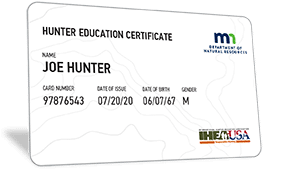
AGE REQUIREMENTS FOR MINNESOTA HUNTERS
Every hunter in Minnesota who was born on or after December 31st, 1979 is required to complete Hunter Education Certification.

MINNESOTA HUNTING EDUCATION REQUIREMENTS
WHAT IS A MINNESOTA HUNTER EDUCATION CERTIFICATE
A Minnesota Hunter Education Certificate proves that you’ve obtained the knowledge needed to hunt safely, responsibly, and ethically, within the state of Minnesota. Any person born after December 31st, 1979, who hunts within the state of Minnesota must get certified.
WHERE CAN I GET MY MINNESOTA HUNTER EDUCATION CERTIFICATE?
You can obtain your Minnesota Hunter Education Certificate by completing a Minnesota Department of Natural Resources-approved course. Courses can be taken either online or in-person, depending on your preference. Hunters who are 11-13 years of age, who choose to complete the course online, will also be required to complete an in-person field day.
Upon completion of the online course students who are 11-13 years of age will be issued a Field Day Voucher. The voucher must be presented in order to gain entry to the field-day portion of the course.
HOW OLD DO I HAVE TO BE TO GET A HUNTER EDUCATION CERTIFICATE IN MINNESOTA?
There is no minimum age to get certified with your Hunter Education Certificate in Minnesota, however, there are supervision requirements for youth hunters.
AGE AND SUPERVISION REQUIREMENTS
Hunters who are less than 9 years of age are not permitted to hunt within the state of Minnesota.
10-13 years of age:
Hunters who are 10-13 years of age are permitted to hunt within the state of Minnesota but must be under the direct supervision of a licensed parent or guardian. The parent of the guardian must be in the immediate reach of the child.
Additionally, hunters who are 10 & 11 years of age are not required to obtain firearms safety training (hunter education certification). Hunters who are 12 years of age or older must get certified in order to hunt legally.
All hunters who are 10-13 years of age must also possess a free license when hunting big game.
14 – 17 years of age:
Hunters who are 14 years of age or older are permitted to hunt unsupervised in Minnesota. They must obtain hunter education certification (firearms safety training), and must also possess the appropriate license for the game animal being hunted. Youth licenses for hunters 14-17 years of age are available at a reduced price.
HOW LONG DOES IT TAKE TO GET MY HUNTER EDUCATION CARD?
It typically takes about 4-6 hours to get your Minnesota Hunter Education Certificate online.
What is an Apprentice Hunter Validation?
The apprentice hunter validation (sometimes called a hunter education deferral), allows hunters who are required to complete hunter education to defer for up to two license years per lifetime. Hunters who have obtained an apprentice hunter validation may only hunt while under the direct supervision of a licensed adult.
The Validation is available for both residents and non-residents of the state from , and cost $3.50.
For more information on Minnesota’s Apprentice Hunter Validation program visit the Minnesota Department of Natural Resources website.
Is my Minnesota Hunter Education Certificate valid in other states?
Yes. The Minnesota Hunter Education Certificate is accepted in all states, provinces, and countries that have mandatory hunter education requirements. Although most regions will accept the Minnesota Hunter Education Certificate, hunters should always be sure to check the rules and regulations of the region where they plan to hunt.
What's the difference between a Hunter Education Certificate and a Hunting License?
A Hunting License is different from a Hunter Education Certificate. While a Hunter Education Certificate proves that you’ve obtained the knowledge you need to hunt safely and ethically in Minnesota, and is different from a Hunting License. The Hunting Licence is similar to a permit and is required to hunt any game animal within the state. Different licenses and permits may be required depending on which game animal is being hunted, and where you plan to hunt.

HUNTING LICENSES, STAMPS AND PERMITS
HUNTING LICENSES
A Hunting License is required in the state of Minnesota to hunt any game animal. There are a variety of license types available depending on your age, residency status, and what type of game you plan to hunt. For a complete list of available hunting license types, visit the Minnesota Department of Natural Resources website.
Resident Adult Hunting License
Resident licenses are available to Minnesota residents only. There are a variety of resident license types available including, sports licenses, small game and trapping, turkey, and big game licenses. Hunters may be required to purchase a game-animal specific license, for example, a deer license or bear license. License types and prices may also vary depending on the age of the hunter.
Non-resident Licenses
Non-resident hunting licenses are available to hunters who wish to hunt within the state of Minnesota but reside in another state, province, or region. Nonresident license types available are similar to those available to residents. The type of license required may be specific to the hunter’s age, and the type of game animal being hunted.
MINNESOTA HUNTER CERTIFICATION AGE REQUIREMENTS
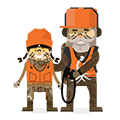
9 YEARS OF AGE OR LESS
Youth who are 9 years of age or younger are not permitted to hunt within the State or Minnesota.

10-13 YEARS OF AGE
Hunters who are 10-13 years of age are permitted to hunt within the state of Minnesota but must be under the direct supervision of a licensed parent or guardian. The parent of the guardian must be within immediate reach of the child.
Additionally, hunters who are 10 & 11 years of age are not required to obtain firearms safety training (hunter education certification). Hunters who are 12 years of age or older must get certified in order to hunt legally.
All hunters who are 10-13 years of age must also possess a free license when hunting big game.
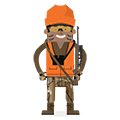
14-17 YEARS OF AGE
Hunters who are 14 years of age or older are permitted to hunt unsupervised in Minnesota. They must obtain hunter education certification (firearms safety training), and must also possess the appropriate license for the game animal being hunted. Youth licenses for hunters 14-17 years of age are available at a reduced price.

18 years of age or older
Hunters who are 18 years of age or older, who were born after December 31st, 1979 are required to complete hunter education certification. Certification is required within the state before a firearms license may be purchased.

Minnesota's Hunting Fines

Hunting without a License or Permit
Up to $1,000

Hunting while under the influence of alcohol and/or a controlled substance
Up to $300

Shining or "Spotlighting"
Up to $3,000

Illegal transportation of big game
Up to $3,000

Illegally buying or selling a wild animal
Up to $10,000
MINNESOTA HUNTING FAQS
DO I NEED A HUNTING LICENSE TO HUNT WITHIN THE STATE OF MINNESOTA?
Yes. A Hunting License is different from a Hunter Education Certificate and is required for any person who hunts within the state of Minnesota. This includes both residents and non-residents. Varying licenses must be purchased and carried depending on the hunter’s age, residency, and the type of game being hunted. Certain exceptions may apply depending on the game animal being hunted.
WHAT ARE THE MINNESOTA TAGGING REQUIREMENTS?
Certain game animals must be tagged after they’re taken. Registration or harvest may also be required for some game animals including deer, bear, and turkey.
Deer Site Tagging and Registration:
Once you’ve harvested your deer, it must be tagged. The site tag must be attached at the site of the kill. The license must be detached from the site tag, and then notched in the appropriate locations to indicate the month, date, and time of day that the animal was taken.
The animal may only be moved from the kill site, without having been tagged, if they are manually dragged or carted from the area while the hunter is carrying the tag on their person. The animal may not be moved using a motor vehicle until the site tag has been attached.
The tag can be attached to the deer using twine, a zip tie, or wire:
- At the base of the antler
- Through a slit cut in the ear
- Between the tendon and bone of the hind leg
The long ends of the wire or string should be left hanging free.
Deer must also be registered after they’re taken. Registration can be completed in-person, via telephone registration, or electronically online. Hunters who wish to register their take online can do so at mndnr.gov/gameregistration
Bear Site Tagging and Registration
Once you’ve harvested your bear, it must be tagged. A site tag will be included with a purchased bear hunting license. The tag must be attached to either the bear sternum, through the ear, or around a leg bone or tendon.
The tag must be validated by punching out or notching the tag to indicate the date of the kill, take method, and sex of the bear. The bear should be tagged on-site if possible or must be in possession of the hunter if the bear is being dragged or carted from the immediate hunting area. The tag must be attached before the animal is moved using a motor vehicle.
Bears must also be registered within 48 hours of being taken. The bear must be presented at a bear registration station, at which point the hunter will be provided with a Big Game Possession Tag. The possession tag can then be affixed to the bear in the same way as the site tag.
Hunters may also choose to register their bear electronically online, or by telephone however, the hunter must still visit a registration station in person in order to pick up a tooth envelope. It is mandatory for hunters to submit a tooth sample for any bear taken.
WHAT ARE THE HUNTER ORANGE REQUIREMENTS IN MINNESOTA?
Hunter orange or pink must be worn by all hunters during any firearms deer season in the state, including muzzleloaders. The orange or pink garments must be worn on the visible portion of the hunter’s gear, and outer clothing worn above the waist. This excludes sleeves or gloves.
Hunter orange or pink camouflage is also permitted as long as there is at least 50% of orange or pink within each square foot of the fabric.
When there is no firearms or muzzleloader deer season taking place, any person who is taking small game must wear hunter orange or pink on a visible portion of at least one article of clothing, worn above the waist.
ARE THERE ANY HUNTER ORANGE EXEMPTIONS?
Certain exceptions to hunter orange requirements may apply depending on the firearms season, and the game animal being hunted. For a complete list of exceptions visit the Minnesota DNR Hunter Orange Requirements page.
WHAT ARE THE BAG LIMITS IN MINNESOTA?
Bag limits are imposed on hunters to restrict the number of a particular game animal that can be taken. Bag limits may be daily or seasonal depending on the type of animal. Daily bag limits restrict the number of a particular game animal that may be taken per day, while seasonal bag limits restrict the number of a particular game animal that may be taken by a hunter within the hunting season.
Bag limits may vary annually depending on game species populations. Hunters must understand and follow bag limit restrictions. Violations may result in fines. For more information on bag limits visit the Minnesota DNR website.

GAME AND NON-GAME SPECIES
GAME SPECIES
The state of Minnesota offers a wide variety of game species for all types of hunters. With a wide variety of landscapes and habitats, not to mention millions of acres of lands that are open to hunting, hunters are sure to find a game animal and hunting opportunity.
Game species in Minnesota include:
- Big game including white-tailed deer, bear, elk, and turkey.
- Small game including various species of grouse, squirrel, prairie chicken, and pheasant.
- Waterfowl and other migratory game birds geese, ducks, coots, and mergansers
- Furbearers including beaver, otter, mink, bobcat, fisher, marten, fox, badger, and opossum
NON-GAME SPECIES
Nongame species within Minnesota make up a large portion of the state’s wildlife and include mammals, birds, fish, reptiles, amphibians, and invertebrates which typically may not be hunted, trapped or fished. They may also be considered a nuisance, or are protected, endangered, or at risk. There is, unfortunately, a lengthy list of endangered, protected, and threatened species within the state including the Canada Lynx, Gray Wolf, various species of birds, bats, insects, plants and mollusks. For more information on nongame, and endangered species within the state visit the Minnesota DNR Endangered Species information page.
INVASIVE SPECIES
Invasive animals and other pests have been introduced to the United States, including the State of Minnesota, and have become a threat to native wildlife. These animals, plants, fish, and invertebrates typically have no natural predators which can result in rapid spread and population growth. This in turn can seriously harm the state’s lands and waters, and can be detrimental to the health and population numbers of a variety of the state’s native plants and animals.
In order to protect Minnesota’s native plants and animals, invasive species must be controlled and eradicated. Anyone who encounters or suspects that they have encountered an invasive species within the state is encouraged to report the sighting so that it can be monitored and controlled. For information on how to report various types of invasive species in Minnesota visit the Minnesota DNR Invasive Species page.

MINNESOTA HUNTING SEASONS
Hunting seasons and dates may change annually per game animal, depending on a variety of factors. Season dates are further broken out by region or permit area. The boundaries of a permit area will vary by animal type. Additionally, seasons are often categorized by firearm time, including archery, firearms, and muzzleloader or “primitive” firearms seasons, and by the age of the hunter (ex. Youth vs. adults vs. senior).
Permit Areas
Permit areas are designated regions within the State of Minnesota, which enhance wildlife management data. Permit area regions are designated by wildlife managers based on factors including natural land features (such as rivers and roads), in addition to habitat similarities, land uses, and the populations of various game animals within the region. Seasons dates for various game animals, firearm types other season types may vary depending on the permits area.
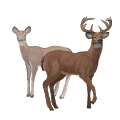
Deer
Deer seasons in Minnesota are organized by firearm type, hunter age, license type and Deer Permit Area (DPA) although some seasons are held statewide. Seasons may also be broken out by deer type (ex. Antlered vs. antlerless). Deer season in Minnesota typically begins in September and ends in mid-December.
Learn more about hunting deer in Minnesota.
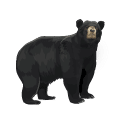
Bear
Bear seasons are organized by type of firearm, permit areas, drawn hunts. Bear quotas may be limited depending on bear populations and permit area. The bear hunting season in Minnesota typically begins in September and ends in mid-October.
Learn more about hunting bear in Minnesota.
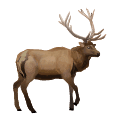
Elk
Elk seasons in Minnesota are organized by firearm type, elk type (antlered, antlerless, and bulls), and by elk hunting ‘zone”. Seasons dates and regulations may vary depending on the zone. Elk season typically opens in August and ends in December.
Learn more about hunting elk in Minnesota.
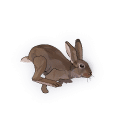
Small Game & Birds
There are several small game animals to hunt in the State including squirrels, ruffed, spruce and sharp-tailed grouse, prairie chicken and pheasant, Seasons dates for small game types vary depending on the game animal type. Most seasons begin in September and continue until January, depending on the animal, and the hunting zone.
Learn more about hunting small game and bird in Minnesota.
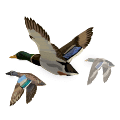
Waterfowl
Duck seasons are organized by zone. There are various waterfowl species to hunt within the state including geese, ducks, coots and mergansers. Seasons dates for waterfowl typically begin in late September and end in December.
Learn more about hunting waterfowl in Minnesota.
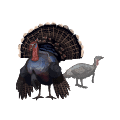
Turkey
Turkey seasons in Minnesota take place in the spring and fall. Turkey hunting is organized into 6 separate seasons. Spring and fall turkey hunts are typically hunter-selected, in which the hunter can choose which seasons dates they’d prefer. There are also surplus seasons, for unfilled licenses and a lottery/surplus season in the early spring. Spring turkey season typically begins in April and ends in May, while the fall season begins in September and ends in October.
Learn more about hunting turkey in Minnesota.
HUNTING ON PUBLIC OR PRIVATE LAND
PRIVATE LAND
Much of the land in Minnesota is privately owned. Hunters can typically freely take game animals hunted on their own private property, or may seek permission from a landowner to hunt on private property. Hunters who wish to take game on privately owned land must follow state hunting regulations as well as any regulations specified by the landowner. Hunters must ensure they respect the rights and property of the landowner at all times – hunting on private land is a privilege.
Walk-in Access Sites
Walk-in access areas allow for public hunting on private land. These spaces are available as a direct result of private landowners who have enrolled in the program to allow hunters access to their property. Hunters must be respectful of these landowners and follow rules and regulations to ensure that these spaces remain open.
Walk-in access areas are open during any legal hunting season from September 1st – May 31st. Hunters must purchase a Walk-in Access (WIA) Validation in order to legally hunt within these areas. Landowners may not give permission to hunters to hunt without the required WIA validation. For more visit the Minnesota DNR Walk-in Access Program page.
PUBLIC LAND
There are millions of acres of public land open to hunting in Minnesota. Popular public lands to hunt within the state include wildlife management areas (WMAs), state and national forests, in addition to federal waterfowl production areas.
The Minnesota DNR manages 1300 WMAs within the state which offer a variety of landscapes and game animal opportunities. Additionally, hunters can access state forests – 3 million acres worth to be specific – which offer a variety of hunting and recreation opportunities, plus Forest Legacy Conservation Areas.
There are also several federally managed lands which are open to hunters within the state including waterfowl production areas, national wildlife refuges, and national forests.
Overall, public hunting land in the state is abundant making it easy for hunters to find a space for hunting just about any game animal of their choosing. For more information on public lands open to hunting within the state, visit the Minnesota DNR Hunting Land Locations page.
Wildlife Management Areas
What Are Wildlife Management Areas?
There are more than 1400 Wildlife Management Areas (WMAs) encompassing 1.29 million acres of land across the state of Minnesota. These areas are open to a variety of public outdoor recreational uses including hunting, trapping and wildlife watching. Regulations within these spaces may vary depending on the region and the type of activities permitted within the area.
WMA Regulations
Specific rules and regulations apply to hunters, trappers, and other recreational users within WMAs. It’s important for hunters to understand the regulations that apply within various WMAs, as they may vary by county. Some example of additional regulations that apply in WMA’s include:
- Restrictions on the use of motorized vehicles
- Firearm type restrictions
- Hunting hours restrictions
- Use of permanent tree stands or blinds
The North Star State. Ready and rarin’ to go.

Where to Hunt in Minnesota
There are plenty of game animals for hunting in Minnesota, in addition to millions of acres on which to hunt them. Deer, turkey, and bear hunters will find no shortage of hunting opportunities – bear hunters, in particular, should focus their attention on the northern and north-central regions of the state including Lycoming County, and Luzerne county.
Lycoming County also borders Susquehannock State Forest, which boasts 265,000 acres of land with plenty of bear, deer, turkey and grouse hunting opportunities. The state also offers plenty of white-tailed deer hunting opportunities. Top spots include Laurel Ridge State Parks, located on the south-east side of Westmoreland County, Racoon Creek State Park, and Beaver County.
The state also offers plenty of upland game hunting opportunities including prime locations for quail and pheasant. There are also dozens of guided tours for a variety of game animals including bear, white-tailed deer, and boar.